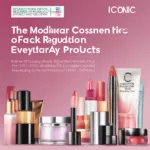24 January 2024
Research Reveals Potentially Harmful Substances in Cosmetics
The beauty industry is a multi-billion dollar market, with countless cosmetic products lining store shelves. However, recent research has shed light on the potential dangers lurking within these seemingly harmless products. Substances found in cosmetics have been linked to various health issues, including hormone imbalances and even cancer. As consumers become more aware of these risks, the need for stricter regulations and oversight has become increasingly apparent. In response, the Modernization of Cosmetics Regulation Act of 2022 (MoCRA) was enacted, granting the Food and Drug Administration (FDA) expanded authority to ensure the safety of cosmetic products. This article explores the research on potentially harmful substances in cosmetics and examines the FDA’s efforts to implement the new regulations.
The Hidden Dangers of Cosmetics
Research has shown that certain substances commonly found in cosmetics can pose serious risks to human health. These substances, added by manufacturers for various purposes, can have long-term effects that may take years to manifest. For example, parabens, commonly used as preservatives, have been linked to endocrine problems in some studies. Other substances, such as asbestos in talc, can be unintentionally present as impurities or byproducts of manufacturing. Inhalation of asbestos is associated with the development of mesothelioma, a deadly form of cancer. These findings raise concerns about the safety of cosmetic products and highlight the need for stronger regulations.
The Modernization of Cosmetics Regulation Act of 2022
Recognizing the need for improved oversight, the MoCRA was enacted to enhance the FDA’s authority over cosmetic safety. The act requires the FDA to take several actions, including issuing standards for detecting asbestos in talc, by specific deadlines through December 2025. While the FDA has taken important steps to implement MoCRA, there are areas where the agency falls short of best practices for successful reform.
Implementation Challenges and Organizational Changes
One of the key challenges faced by the FDA is the lack of a comprehensive implementation plan for MoCRA. The agency has relied on the law itself as its roadmap, but the law does not provide detailed interim steps or deadlines. This approach hampers effective project management and could lead to delays or confusion in implementing the necessary changes. To ensure successful implementation, the FDA should develop a detailed plan that outlines the steps and timelines for each aspect of MoCRA.
Workforce Planning for Effective Oversight
Another area where the FDA can improve its implementation efforts is through strategic workforce planning. Leading practices suggest that the agency should have a workforce plan in place to ensure it has the necessary personnel with the required skills and competencies to exercise its new authorities. However, the FDA has not developed such a plan, citing its focus on meeting near-term MoCRA deadlines. By neglecting workforce planning, the FDA risks being ill-equipped to effectively enforce the new regulations and ensure the safety of cosmetic products.
State Laws and Regulations
While the MoCRA grants the FDA expanded authority, it is worth noting that some states have already taken steps to regulate cosmetic safety. Several states have implemented laws and regulations that prohibit or restrict certain substances in cosmetics. These state-level efforts serve as a reminder of the urgency and importance of ensuring consumer safety in the absence of comprehensive federal regulations.
Conclusion:
The potential dangers lurking in cosmetic products highlight the need for stronger regulations and oversight. The MoCRA represents a step in the right direction, granting the FDA expanded authority to ensure the safety of cosmetic products. However, the FDA must address the implementation challenges it currently faces, including the lack of a comprehensive plan and strategic workforce planning. By doing so, the FDA can better protect consumers and promote the safety of cosmetic products. As the beauty industry continues to thrive, it is crucial that consumers have confidence in the products they use, knowing that their health and well-being are not compromised.



